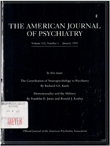Diagnostic and substance specificity of carbon-dioxide-induced panic
Abstract
OBJECTIVE: The authors assessed the substance and diagnostic specificity of carbon-dioxide-induced panic since, in addition to the specific biochemical effects of inhaled carbon dioxide (CO2), simple physiologic distress is also frequently implicated as a panicogenic factor during respiratory challenge studies with CO2 in patients with anxiety disorders. METHOD: Eighteen patients with panic disorder, 20 with social phobia, and 23 psychiatrically normal subjects inhaled a mixture of 35% CO2 and 65% O2 for 30 seconds through a face mask. They also breathed for 30 seconds through a valve reducing the diameter of the airway. A double-blind, counterbalanced, randomized design was used. RESULTS: In spite of important similarities between the two interventions, including the induction of equal amounts of subjective respiratory distress, carbon dioxide inhalation was significantly more potent than increased airway resistance in provoking panic in the anxiety disorder patients. The patients with panic disorder were significantly more sensitive to CO2 than were the patients with social phobia or the normal subjects. CONCLUSIONS: Carbon dioxide inhalation appears to have a specific panicogenic effect in panic patients that goes beyond simple breathlessness.
Access content
To read the fulltext, please use one of the options below to sign in or purchase access.- Personal login
- Institutional Login
- Sign in via OpenAthens
- Register for access
-
Please login/register if you wish to pair your device and check access availability.
Not a subscriber?
PsychiatryOnline subscription options offer access to the DSM-5 library, books, journals, CME, and patient resources. This all-in-one virtual library provides psychiatrists and mental health professionals with key resources for diagnosis, treatment, research, and professional development.
Need more help? PsychiatryOnline Customer Service may be reached by emailing [email protected] or by calling 800-368-5777 (in the U.S.) or 703-907-7322 (outside the U.S.).



